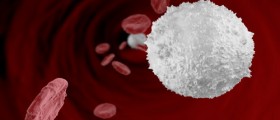High Red Blood Cell Count
Red blood cells (RBCs) are known as erythrocytes and they perform the most important function of the blood. Main role of red blood cells is to carry oxygen and supply it to different organs of the body. Red blood cells contain hemoglobin which enables transportation of oxygen from lungs to every tissue of the body.
An increased red blood cells count in the bloodstream means that there is an excess of red blood cells. Red blood cells count refers to number of red blood cells per cubic millimeter of blood. Normal RBC value in adults is around 5.0 million. High red blood cells count is also known as erythrocytosis and it refers to RBC value above 5.72 million for men and 5.03 million for women.
- Posture: When a blood sample is obtained from a healthy person in a recumbent position, the RBC count is 5% lower.
- Dehydration: Hemoconcentration in dehydrated adults may obscure significant anemia.
- Age: The normal adult RBC count is reached at age 14 years and is maintained until older age, when there is a gradual drop.
- Blood clots: The blood sample must not be clotted (even slightly) or the values will be invalid.
- Venipuncture: Falsely high counts may occur because of prolonged venous stasis during venipuncture.
Causes for High Red Blood Cell Count
This condition may occur as a response to low oxygen levels in the body because of improper functioning of the heart or the lungs. If kidneys secrete excess protein, known as erythropoietin or EPO, it will result in elevated red blood cells count. Sometimes, the cause lies in overproduction of red blood cells in the bone marrow. High red blood cells count may result from impaired ability of the cells to carry oxygen.
Elevated RBC value occurs at high altitudes due to low ambient oxygen levels. Strenuous exercises can also cause enhanced red blood cells production because increased muscle mass requires more oxygen. Finally, high red blood cells count can result from the loss of blood plasma, the liquid component of the blood.
High red blood count may occur because of certain specific causes such as:
1. Use of anabolic steroids which enhance production of red blood cells
2. Congenital heart disease
3. Chronic obstructive pulmonary disease (COPD)
4. Use of injectable erythropoietin (EPO) to improve performance of athletes in competitions
5. Heart diseases
6. Hemoglobinopathy, a genetic defect that causes production of abnormal hemoglobin
7. Kidney cancer
8. Living in high altitudes
9. Renal hypoxia
10. Lung diseases
11. Pulmonary fibrosis
12. Smoking
13. Polycythemia vera, a condition characterized by elevated white blood cell and platelet count.
Symptoms of High Red Blood Cell Count
Not all people with high red blood cell count experience the same symptoms. It depends on number of factors and underlying causes of the condition. Some people have only mild symptoms while others may suffer a lot of discomfort because of elevated red blood cell count.
In some cases, this condition is followed by other blood disorders such as bleeding and clotting problems. Common symptoms that are associated with high red blood cell count include: headaches, fatigue, weakness, dizziness, abdominal pain, itching, joint pain, and bruising.

















Your thoughts on this
Loading...